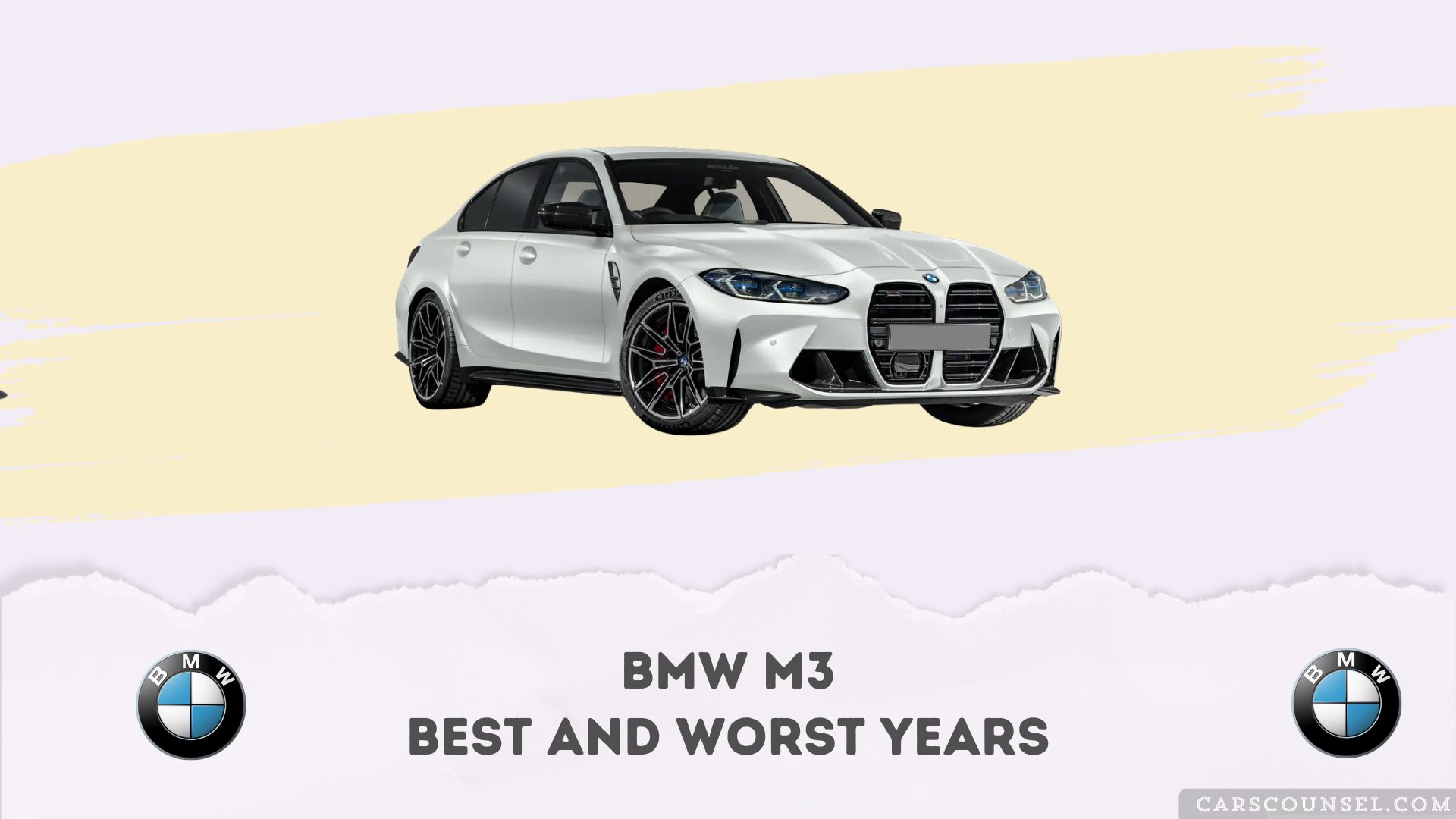When considering the best and worst BMW M3 years, you’ll find varying opinions. The E46 model is often praised for its performance, but it also has reliability issues. Meanwhile, the E36, particularly in the U.S., is less favored due to its detuned engine.
The F80, with its shift to turbocharged engines, is another point of contention. As you examine these models, you’ll discover more about their strengths and weaknesses.

Quick Navigation
Key Takeaways
- E46 M3 (2000-2006): Renowned for its high-revving nature and sharp handling, despite some engine issues.
- E92 M3 (2008-2013): Praised for its powerful V8 engine and addictive exhaust note.
- E30 M3 (1986-1991): Iconic for its origins as a road-legal race car, though it faced reliability issues.
- F80 M3 (2014-2018): Early models were criticized for aggressive handling, but later versions improved.
- G80 M3 (2020-present): Sets performance benchmarks with advanced tech and powerful engines.
BMW M3 History and Evolution
The BMW M3’s 35-year history is marked by its evolution from a humble homologation special to a benchmark-setter in the sports car segment.
Each generation has brought significant advancements.
Starting with the E30, which dominated the DTM with its 2.3-liter inline-four engine, the M3 has evolved through multiple generations.
The E46 and E92 models followed, with the E46 featuring the S54 inline-six engine.
The F80 M3 introduced turbocharging, while the latest G80 generation raises the bar with its powerful engine options, showcasing BMW’s M division‘s relentless pursuit of performance.
These updates have solidified the M3’s status in the BMW M lineup.
Legendary Status and Performance
BMW M3’s legendary status rests on its origins as a road-legal race car designed to dominate motorsports, a foundation that has continually resonated with driving enthusiasts worldwide.
Over its history, each M3 generation has pushed performance limits, from the E30’s inline-four engine to the twin-turbocharged inline-six in the F80 and G80 models, delivering over 400 horsepower.
The M3’s engine evolution has been significant, and its iconic design, evolving from the boxy E30 to the sleek G80, has mesmerized enthusiasts.
This blend of power and style cements the M3’s status as an iconic sports car.
Engine Evolution Over the Years
Although the BMW M3 started with a high-revving four-cylinder engine in the E30 generation, its engine evolution has seen dramatic growth in power and sophistication.
The E46 M3 introduced the acclaimed S54 inline-six, delivering 333 horsepower with razor-sharp throttle response.
Moving into the E92, BMW debuted a 4.0-liter V8, the only V8 in M3 history, making 414 horsepower.
The F80 M3 switched to a twin-turbo inline-six, breaking the tradition of naturally aspirated engines and producing 425 horsepower.
Finally, the G80 M3’s twin-turbo six now delivers up to 503 horsepower, pushing performance to new levels.
Reliability and Maintenance Costs
As you consider purchasing a BMW M3, you’ll want to look at its reliability ratings.
The BMW M3 a below-average reliability rating of 2.0 out of 5.0, placing it low among luxury midsize cars, with an average annual repair cost of $1,161, which is significantly higher than most vehicles in its class.
You should be aware of common issues like engine noises, transmission problems, and radiator faults, which can lead to costly repairs.
Reliability Ratings
When evaluating the reliability and maintenance costs of the BMW M3, you’ll find that it scores a relatively low reliability rating of 2.0 out of 5.0, ranking it 29th out of 31 luxury midsize cars according to RepairPal.
The average annual repair cost is $1,161, higher than many competitors. This indicates you should expect more frequent and potentially severe repairs.
Certain model years, like the 2002 M3, have engine and transmission issues, while early E30 models faced rust and engine reliability problems, all contributing to higher maintenance costs.
Common Known Issues
Common issues with the BMW M3 primarily revolve around its reliability and maintenance costs.
Transmission problems are particularly prevalent, especially with the SMG transmission in older models like the E46, where owners frequently report issues that require costly repairs.
Engine failures have been reported in several model years, significantly the 2002 and 2008 models, with common problems including rod bearing failures and premature engine damage.
Early models (1986-1991 E30) faced rust and engine oil leaks.
Additionally, rear subframe cracks are a serious issue that can lead to expensive repairs and affect vehicle safety.
Annual Repair Costs
The annual repair costs for a BMW M3 can be significant, averaging around $1,161 per year, according to RepairPal. This is higher than many competitors, reflecting the model’s lower reliability rating.
| Model Year | Common Issues | Annual Cost Impact |
|---|---|---|
| 2002 | Engine and transmission problems | Increased costs |
| Early E30 | Rust and engine reliability | Higher costs |
| General | Frequent repairs needed | Average $1,161/year |
Common Issues and Model Years to Avoid
As you evaluate the BMW M3, you’ll notice specific model years are prone to significant issues.
Engine and transmission failures are particularly common in models like the 2008 M3, where the S65 engine can experience rod bearing failures and the DCT transmission may exhibit lag and responsiveness issues.
Additionally, older models such as the E46 may suffer from rear subframe cracks, a costly repair, while earlier models like the E30 faced issues with rust and engine reliability.
Engine and Transmission Failures
How will you navigate the potential pitfalls of engine and transmission failures in your BMW M3?
The 2002 model year is particularly prone to issues like subframe cracks and problematic SMG transmissions, which can lead to costly repairs.
Engine problems, such as VANOS timing issues and rod bearing failures, are common.
Transmission failures often require frequent and expensive maintenance.
Additionally, early model years like the E30 and E36 had their own set of issues, including engine reliability and transmission problems.
These factors can significantly increase maintenance costs over time.
Rear Subframe and Chassis Issues
Rear subframe and chassis issues in BMW M3s have proven a persistent headache for owners, especially those driving models from certain years.
The E46 M3 models, particularly those from 2000 to 2006, are prone to subframe cracks, a costly repair.
These cracks often occur near the rear subframe mounts due to failed bushings and stress from the drivetrain.
Even if you find a good deal, such models will likely require significant maintenance, making them years to avoid.
The E30 M3: The Original Legend
The BMW M3 E30 is an iconic symbol of motorsport excellence, developed specifically to dominate the DTM racing series.
It set the precedent for all subsequent M3 models with its race-ready design and analogue driving feel.
- Powered by a 2.3-liter S14 inline-four engine with around 192 horsepower.
- Known for its lightweight frame, making it a true driver’s car.
- First M3 model, introducing a raw, analogue driving experience.
- A motorsport icon, prized among collectors and drivers for its historical significance.
The E36 M3: An Underrated Generation
Produced from 1992 to 1999, the E36 M3 marked a significant shift from its predecessor, the E30, by introducing a more refined and comfort-oriented sports sedan.
With a well-balanced chassis and refined suspension, the E36 M3 offered impressive agility and stability, blending daily drivability with performance.
Considered underrated, it set new standards for future M3 generations by evolving the concept into a modern, versatile sports car.
The E36 M3 remains a standout for those seeking a balance of comfort and formidable handling, proving its legacy in the M3 lineage.
The E46 M3: A Performance Icon
When considering the E46 M3, you’ll encounter both its exceptional performance and some notable reliability concerns.
The car’s S54 inline-six engine, with its naturally aspirated design and sharp throttle response, is a highlight, but it also comes with issues like premature rod bearing wear and VANOS system problems.
Your evaluation of the E46 M3 will depend on weighing its legendary performance capabilities against potential maintenance costs and repair needs.
Engine & Performance
Anxious drivers stepping into an E46 M3 encounter a highly revered heart—the S54 inline-six engine, delivering 333 horsepower with razor-sharp throttle response, linear power delivery, and a high-revving character.
Characteristics that have earned it legendary status in the enthusiast community.
The S54 shares the spotlight with BMW’s later S65 engine (naturally aspirated V8), but it’s the S54’s accessible approachability that sets it apart.
- 333 HP S54 inline-six: Renowned for its crisp throttle and linear power curve.
- High-revving nature: Thrives near the redline, rewarding spirited driving.
- Accessibility: Easy for drivers of any skill to exploit its full performance.
- Lightweight chassis: Amplifies agility and responsiveness on-road or track.
Reliability Concerns
While the E46 M3’s S54 engine is celebrated for its performance, it also comes with reliability concerns that can impact ownership.
The most notorious issues include rod bearing failures and VANOS system problems. Early models, especially those built before 2004, are more prone to rod bearing failure due to manufacturing variances and insufficient oiling at high RPMs.
The VANOS unit is another weak spot, often requiring costly repairs or preventative upgrades.
Regular maintenance and proactive replacements of known weak points are essential to keep your BMW M3 running reliably and to avoid catastrophic engine damage.
The E92 M3: A V8 Powerhouse
The BMW E92 M3 stands out as a powerhouse in the M3 lineage, thanks to its high-revving 4.0-liter V8 engine.
This model is the only M3 ever offered with a naturally aspirated V8, delivering 414 horsepower and a spine-tingling redline at 8,400 rpm.
- V8 Thrill: The 4.0-liter S65 V8 engine is renowned for its willingness to rev, producing a unique, addictive exhaust note and raw power that’s rare in modern cars.
- Muscular Design: It features bold styling cues—unique bumper, side skirts, rear diffuser—matching its muscular engine.
- Driver Focus: Advanced suspension and precise, agile handling make every drive engaging and rewarding.
- Auditory Appeal: The V8’s roar and responsiveness create an unforgettable driving experience.
The F80 M3: A Modern Approach
You’re stepping into the era of the F80 M3, a model that marked a significant departure from its predecessors.
The F80 M3, produced from 2014 to 2018, featured a twin-turbocharged 3.0-liter inline-six, producing 425 horsepower and 406 lb-ft of torque.
It introduced advanced technology like adaptive suspension and driver-assist features, while maintaining rear-wheel drive.
Early models were criticized for aggressive handling, but later iterations improved this.
Despite modernizations, the F80 M3 remained a refined driver’s car.
The G80 M3: A New Era of Performance
Building on the F80 M3’s modern approach, the G80 M3 represents a significant leap forward in performance and technology.
As you delve into this new era of BMW, you’ll find:
- Exceptional Power: The G80 M3’s twin-turbo 3.0-liter engine produces up to 503 horsepower in the Competition variant.
- Advanced AWD: It features one of the best all-wheel-drive systems available.
- Cutting-Edge Tech: The inclusion of driver-assist systems and advanced drive modes amplifies its appeal.
- Performance Benchmark: It sets a new standard for the M3 lineup, marking a new era in BMW performance.
When looking at performance cars, make sure to check out our guides on models like the BMW M4, BMW 8 Series, BMW I3 and BMW X7. Knowing which model years to target and which to avoid is crucial. Our expert reviews break down these models, providing insights into the years that are celebrated for their engineering excellence and driving satisfaction, as well as those that are best to avoid due to potential issues.

